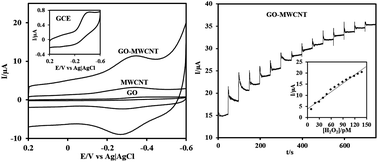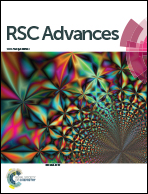Direct electrochemistry of cytochrome c immobilized on a graphene oxide–carbon nanotube composite for picomolar detection of hydrogen peroxide
Abstract
We describe the fabrication of an amperometric biosensor based on cytochrome c (Cyt c) immobilized graphene oxide–multiwalled carbon nanotube (GO–MWCNT) composite on a nano Au modified glassy carbon electrode for trace level detection of H2O2. Morphology and surface characterization of the nanocomposite reveal the successful formation of a highly conducting MWCNT network on the GO surface. Electrochemical impedance studies indicate a lower charge transfer resistance compared to the bare electrode. Cyclic voltammetry studies clearly demonstrate an enhanced direct electrochemistry of Cyt c with a high electron transfer rate constant (ks) value of 3.4 s−1. An amperometric H2O2 biosensor has been fabricated with an excellent current sensitivity of 0.533 μA pM−1 cm−2 and a very low detection limit of 27.7 pM. The fabricated sensor shows exceptional selectivity to H2O2 in the presence of a high concentration of some likely interferents. Moreover, the sensor exhibits high stability with appreciable repeatability and reproducibility.

- This article is part of the themed collection: Nanoscience and nanotechnology in electrochemistry

 Please wait while we load your content...
Please wait while we load your content...